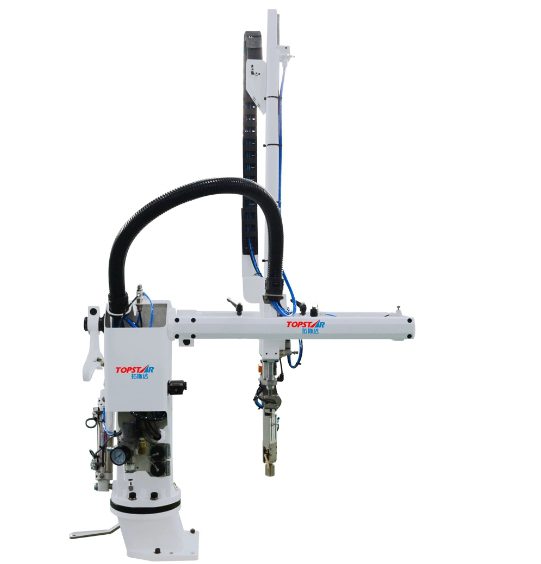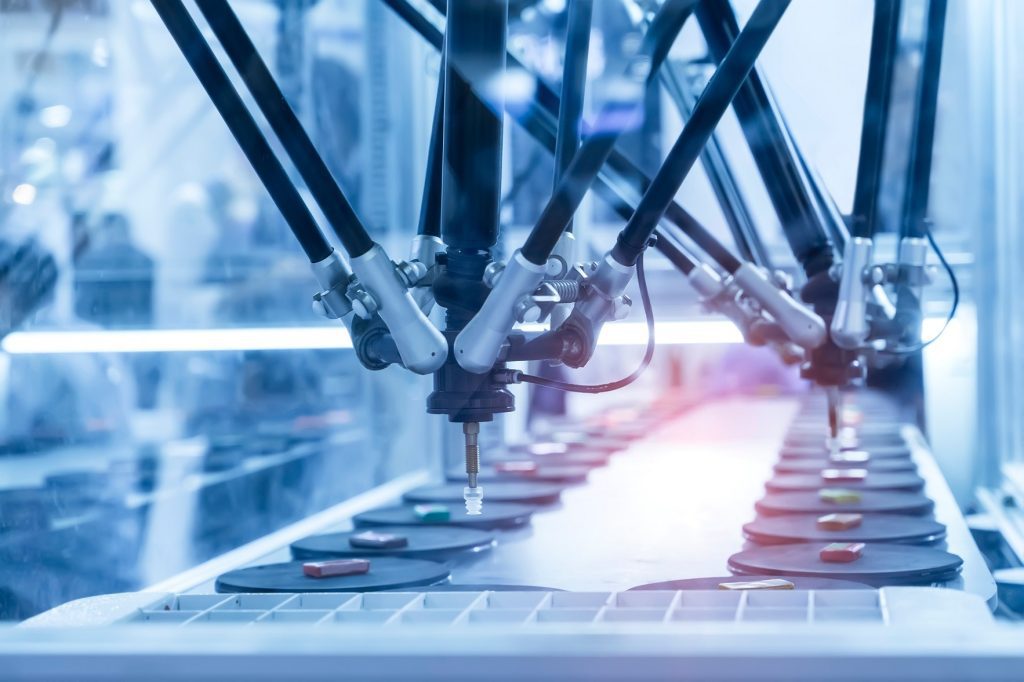Enhancing Injection Manipulator Efficiency with Predictive Maintenance
2023/11/08 By Topstar

We have emphasized “efficiency” more than once, and optimizing efficiency is our constant pursuit. Plastics manufacturers rely heavily on Injection Manipulator to maintain precision and consistency in their production processes. However, as these machines are subject to continuous wear and tear, ensuring their reliability and performance becomes increasingly challenging. This is where predictive maintenance comes in, revolutionizing how we manage these critical tools.
Understand the predictive maintenance of Injection Manipulator!
Predictive maintenance relies on the collection and analysis of large amounts of data. Topstar‘s injection Manipulators have sensors and IoT (Internet of Things) technology to collect and transmit real-time data. These sensors monitor vital parameters and provide a continuous stream of data to maintenance teams. Machine learning algorithms then process this data, identifying patterns and anomalies that may indicate impending problems. Predictive maintenance methods involve a combination of technologies such as vibration analysis, thermal imaging, and more. These technologies help monitor the condition of injection robots and predict when maintenance or repairs are needed.

Benefits of predictive maintenance for Injection Manipulator
The advantages of implementing predictive maintenance on injection robots are manifold. First and foremost, it significantly reduces downtime, thereby increasing productivity. By identifying potential issues in advance, maintenance can be scheduled during planned downtime, ensuring minimal disruption to production. This can result in significant cost savings, as emergency maintenance and unplanned downtime are expensive for repairs and lost production. Another important benefit is that it extends the life of your equipment. Predictive maintenance can minimize wear and tear on critical components by fixing problems before they escalate into serious issues. This not only reduces the frequency of equipment replacement but also extends the overall service life of the injection robot, resulting in further cost savings.
Data-driven decision-making in injection Manipulator maintenance
The success of predictive maintenance depends heavily on the availability and analysis of accurate data. The injection robot is equipped with various sensors, including temperature, pressure, and cycle time sensors, to collect data during operation continuously. These sensors provide information that enables machine learning algorithms to make predictions and recommendations based on patterns and deviations. Machine learning algorithms can evaluate the data and provide insights into the health of the injection robot. For example, if a specific sensor reading deviates from expected values, the algorithm can flag it as a potential problem. The maintenance team can then work on solving the problem.
Perform remote monitoring
Today’s IoT technology allows for real-time monitoring of the performance of injection Manipulators, even from remote locations. Remote monitoring provides real-time insight into the status of the injection robot, enabling maintenance teams to track key performance indicators such as temperature, pressure, cycle time, and energy consumption. This continuous data flow enables maintenance professionals to detect problems and take immediate action, minimizing the risk of unplanned downtime. This level of remote visibility and control is critical to increasing efficiency and minimizing costs, especially in large-scale manufacturing environments where timely resolution of issues is critical.
Case Study: Improving Practical Efficiency through Predictive Maintenance
To highlight the effectiveness of predictive maintenance on injection robots, let’s explore a few real-life case studies. These examples illustrate how this approach translates into tangible efficiency gains for manufacturers.
Case Study 1: Automotive Manufacturing
A significant automaker implemented predictive maintenance for injection robots in its production line. By continuously monitoring the performance of their equipment and analyzing the data, they can predict maintenance needs with great accuracy. As a result, they reduced unplanned downtime by 40% and increased the overall efficiency of the injection molding process.

Case Study 2: Medical Device Manufacturing
In the highly regulated medical device manufacturing industry, precision and reliability are critical. A manufacturer of complex medical components integrates predictive maintenance into its injection robot system. This allows them to maintain strict quality standards and avoid unexpected equipment failures. The result is a 30% increase in efficiency.
These case studies highlight how predictive maintenance can deliver real efficiency gains for manufacturers, ensuring production processes remain smooth, cost-effective, and reliable.

Final summary
By harnessing the power of data and technology, manufacturers can increase injection robot efficiency, reduce downtime, and ultimately increase profits. At the same time, predictive maintenance is also reshaping how manufacturers manage injection molding robots, ensuring they operate at peak efficiency and remain the cornerstone of their production processes.
TRENDING POSTS
- What factors can cause delays in the injection molding process of plastic molding machine? 2023/11/08
- Exhibition Review| Topstar participates in InterPlas Thailand 2024 2023/11/08
- Star Case | Topstar helps Santong upgrade its intelligent plant 2023/11/08
- Topstar Special | National Science and Technology Workers Day 2023/11/08
HOT TOPIC
- 3 in 1 Compact Dehumidifying Dryer
- 5-axis CNC machine
- accuracy
- Air Chillers
- all electric injection molding machine
- All-electric injection molding machines
- and overall production quality. Therefore
- AP-RubberPlas
- automated injection molding machine
- Automation changed engineering
- automation of injection molding robots
- auxiliary machine
- Bench Injection Molding Machine
- Cabinet dryer manufacturers
- Cabinet dryers
- chiller
- CNC Drilling Machine
- CNC Drilling Machines
- cnc engraving machine manufacturer
- cnc laser cutting machine manufacturer
- CNC machine
- CNC Machine Center
- CNC Machine for Sale
- CNC Machine Manufacturing
- CNC Machine Tool
- CNC machine tool product
- CNC Machining Center
- CNC wood carving machine
- Cooling system
- Cross-Walking Single Axis Servo Cylinder Robot
- Cross-Walking Single-Axis Servo Cylinder Robot
- Cross-Walking Three-Axis/Five-Axis Servo Driven Robot
- cross-walking three-axis/five-axis servo-driven robot
- Dehumidifier Dryer
- Dehumidifying Dryer
- delta parallel robot
- Desktop Injection Molding Machine
- Desktop injection molding machines
- Desktop Molding Machine
- desktop plastic injection machine
- Desktop Plastic Injection Molding Machine
- direct clamp injection molding machine
- Direct clamp injection molding machines
- Dosing & mixing system
- Drilling Centers
- Drying and dehumidification system
- drying and dehumidifying equipment
- Drying and Dehumidifying System
- drying system
- effective and efficient. Cabinet dryers are also used in other industries where large quantities of material need to be dried
- efficient injection molding machine
- elbow hydraulic injection molding machines
- electric injection molding machine
- electric injection molding machines
- etc. Among injection molding robots
- exhibition
- features of CNC machine
- Feeding And Conveying System
- Five Axis Machine Center
- Fully automatic injection molding machine
- Gathering Topstar
- giant injection molding machine
- GMU-600 5-Axis Machining Center
- Granulating & Recycling System
- Heavy duty injection molding machine
- Honeycomb rotor dehumidifier
- horizontal injection molding machine
- Horizontal Injection Molding Machines
- Horizontal Injection Moulding Machine
- Horizontal Mixer manufacturer
- How The CNC Machine Works
- hybrid injection molding machine
- hydraulic injection molding machine
- Hydraulic Injection Molding Machines
- in this article
- Industrial robot
- Industrial Robot Chinese brand
- industrial robot parts
- industrial robot supplier
- Industrial robots
- Industry Chain
- Injection Manipulator
- injection mold machines
- Injection molding
- Injection molding automation
- Injection Molding Automation Solution
- injection molding dryer
- Injection molding equipment
- injection molding hopper dryer
- Injection molding machine
- injection molding machine brand
- Injection Molding Machine Factory
- Injection Molding Machine Manufacture
- Injection molding machine manufacturer
- injection molding machine manufacturers
- Injection molding machine procurement
- injection molding machine robotic arm
- injection molding machine with a robot
- Injection molding machines
- injection molding material dehumidifying
- injection molding plant
- Injection Molding Robot
- injection molding robot arm
- Injection molding robot automation
- Injection molding robotic arm
- injection molding robots
- Injection Moulding Robots
- Injection Robot
- Injection robot arm
- Injection robot manufacturer
- Injection robot wholesale
- injection robots
- intelligent injection molding machines
- Introducing Injection Robot
- It is the best choice for drying large quantities of material at once. Cabinetmakers use these machines because they are fast
- large injection molding machine
- Learn what industrial automation and robotics is
- low speed sound-proof granulator
- machine plastic molding
- make sure to add some! Improvements (2) Keyphrase in introduction: Your keyphrase or its synonyms appear in the first paragraph of the copy
- manipulator machine
- manufacturing
- micro injection molding machine
- middle speed granulator
- Mini CNC machine manufacturers.
- Mold Temperature Control System
- mold temperature controller
- molding material Dehumidifying System
- mould temperature controller
- mould temperature controllers
- New electric injection molding machine
- nitrogen dryer manufacturer
- nitrogen dryer system manufacturer
- Oil type mold temperature controller
- open day
- Outbound links: No outbound links appear in this page. Add some! Images: No images appear on this page. Add some! Internal links: No internal links appear in this page
- PET Preform injection molding
- phone case maker machine
- phone case making machine
- plastic bottle making machine
- plastic bottle manufacturing
- plastic bucket making machine
- plastic bucket manufacturing
- Plastic chair making machine
- plastic forming equipment
- plastic hopper dryer
- plastic injection machine
- plastic injection machines
- plastic injection molding
- Plastic injection molding equipment
- Plastic injection molding machine
- Plastic Injection Molding Machines
- plastic injection robot
- Plastic Molding machine
- Plastic Molding Machines
- plastic molding press
- plastic phone case making machine
- plastic-molding machine
- powerful granulator
- Powerful Type Sound-Proof Granulator
- production of plastic seats
- Robot injection molding
- robot injection molding machine
- robot manufacturing companies
- Robotic arm for injection molding machine
- robotic injection molding machines
- robotics in injection molding
- SCARA robot
- SCARA robots
- Service-oriented manufacturing
- Servo Cylinder Robot
- servo driven robot
- Servo Driven Robots
- servo injection robots
- Servo-Driven Robot
- Setup of injection machine
- Silicone Injection Molding Machine
- six-axis industrial robot
- Stainless Hopper Dryer
- Stainless Hopper Dryers
- star club
- swing arm robot
- the choice between servo-driven robots and hydraulic robots will have a certain impact on efficiency
- the most popular injection molding machine
- the type of injection molding robot
- toggle clamp injection molding machine
- Toggle Hydraulic Injection Molding Machines
- toggle injection molding machine
- Top 10 brands of injection robots
- Topstar
- Topstar Engineering
- Topstar Industrial Robots
- Topstar injection molding intelligent
- Topstar Scara Robots
- Useful Injection molding machine
- Vertical machining centers
- volumetric type blender
- water chiller
- water chillers
- water distributor
- Water Type MoldTemperature Controller
- We often face choices when performing injection molding. We will choose the type of injection molding machine
- wholesale of injection molding machines
- x carve CNC
